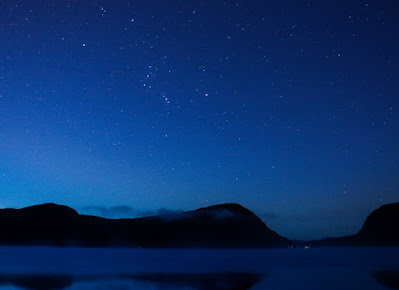Physics Photo of the Week - September 8, 2023 - Orion in August
Orion in August - Photo by Donald Collins
Orion the Hunter is a well-known constellation of bright stars that is very vivid in January. It is known as a "winter constellation" because it is usually seen in the winter months. Clicking on the image shows a larger image with the constellation shape outlined.
This image was made from Willoughby Lake in Vermont about 2 1/2 weeks ago on August 23, 2023. How can we see the familiar winter constellation in the summer? Is it due to the location on Earth and the view of the sky from a more northern location? Is it due to the time of night that the sky was viewed? Or, is it due to the phase of the Moon?
The answer is the second choice: the time of night that the photograph was made. I had gotten up at 5 am and took this photo when the air was extremely clear in the pre-dawn sky. The stars are at vast distances from the Earth and the Solar System. As the Earth orbits the Sun within the Solar System, the constellations and stars are relatively fixed in space. The Sun must be blocked from view in order to see any stars. The Sun's glare lighting up the sky prevents us from seeing stars in the daytime. In June, the Earth is on the opposite side of the Sun from Orion, and Orion is blocked by the glare from the Sun. Two month's later, the Earth moved about 1/6 of its orbit about the Sun and Orion is offset from the direction of the Sun, but we can only see it while the Sun is below the Earth's horizon - before dawn. In the 1/6 of the year since the Sun was blocking our view of Orion, Orion appears about 1/6 of a complete circle (60 degrees) from the direction of the Sun. In the picture we can see the twilight pre-dawn sky indicating that the Sun is about 60 degrees to the left of Orion and below the horizon.
A more graphic example of the same effect follows: imagine there is building in the distance, but the view of the building is blocked by a relatively close streetlamp. The glare of the streetlamp blocks out the view of the distant building. But if you step to one side, like going partly around an orbit around the streetlamp, you can eventually see the distant building - especially when blocking the streetlamp from view. The Earth's horizon blocks the view of the Sun in the pre-dawn situation above.
In the following months, the Earth's orbit causes the Sun to appear further and further east in the sky. The stars in the sky appear further and further west relative to the Sun. In December - when Earth has moved half an orbit since June - Orion will be in opposition, meaning in the direction opposite the Sun. In December Orion will appear at its maximum height above the horizon at midnight. In January Orion will be west of the highest position at midnight, but in prime position during early evening. During the fall months, if you are up before dawn, look for Orion in the south-eastern sky.
Orion is mostly noted for its bright stars that form the hunter's belt. He has a narrow waist. Hanging from the belt is the hunter's sword formed by some "fuzzy" star-like objects visible in the photo at right. The fuzzy object within the sword - at the exact center of the image - is the Great Orion Nebula - a very enticing object where stars are actually being born!
A telescope image of the Orion nebula was last featured in Physics Photo of the Week on February 8, 2019 .
======================================================================
Physics Photo of the Week is published weekly during the academic year on Fridays by the Warren Wilson College Physics Department. These photos feature interesting phenomena in the world around us. Students, faculty, and others are invited to submit digital (or film) photographs for publication and explanation. Atmospheric phenomena are especially welcome. Please send any photos to dcollins@warren-wilson.edu.
All photos and discussions are copyright by Donald Collins or by the person credited for the photo and/or discussion. These photos and discussions may be used for private individual use or educational use. Any commercial use without written permission of the photoprovider is forbidden.





Comments
Post a Comment